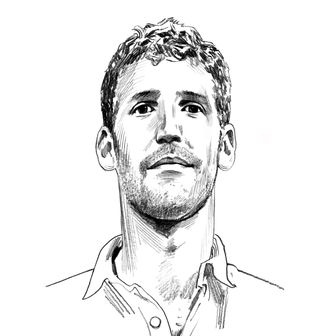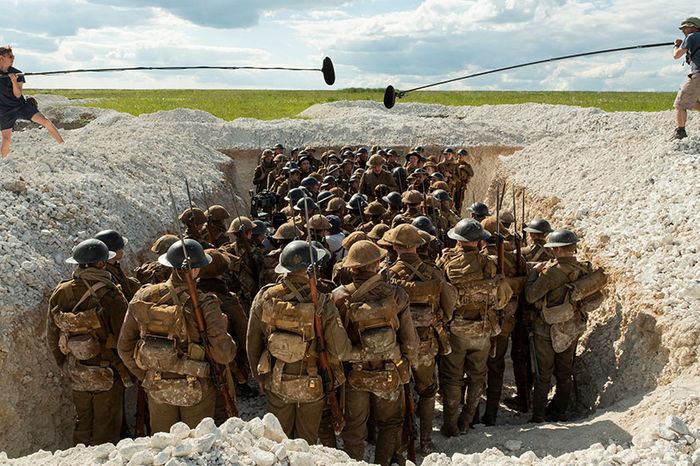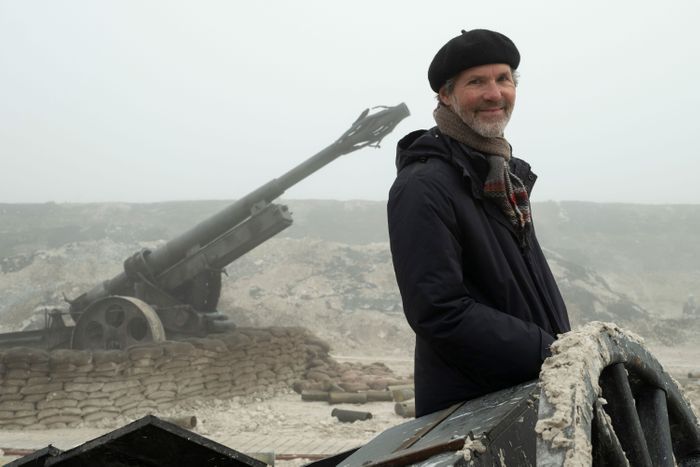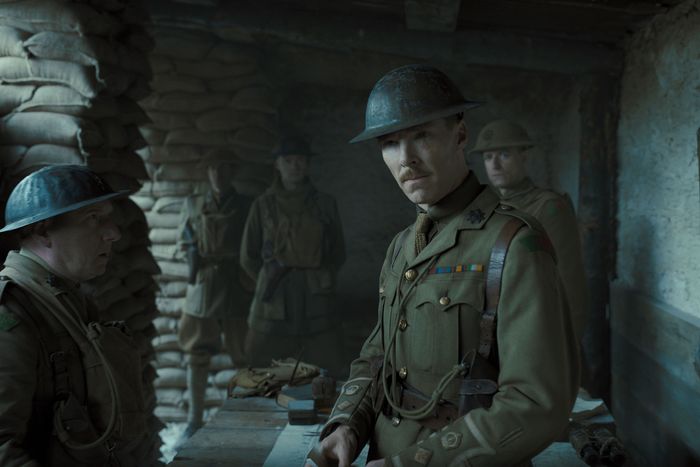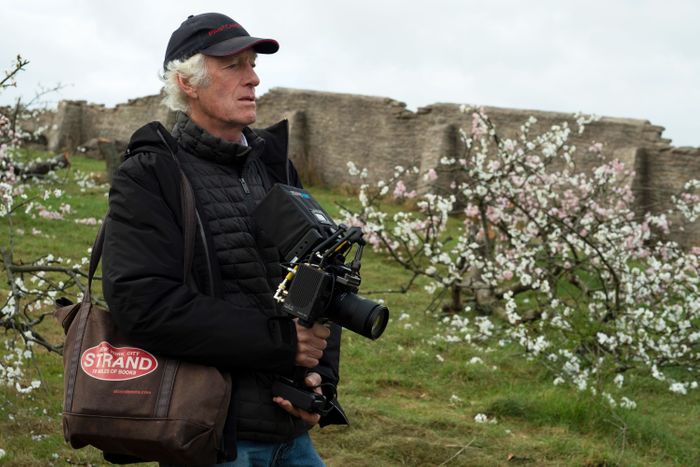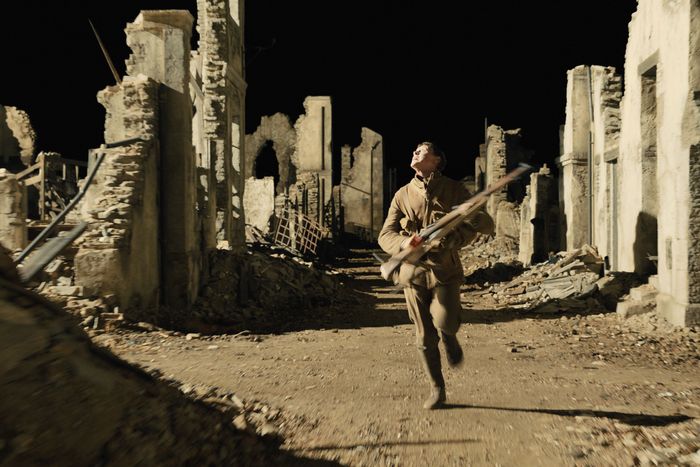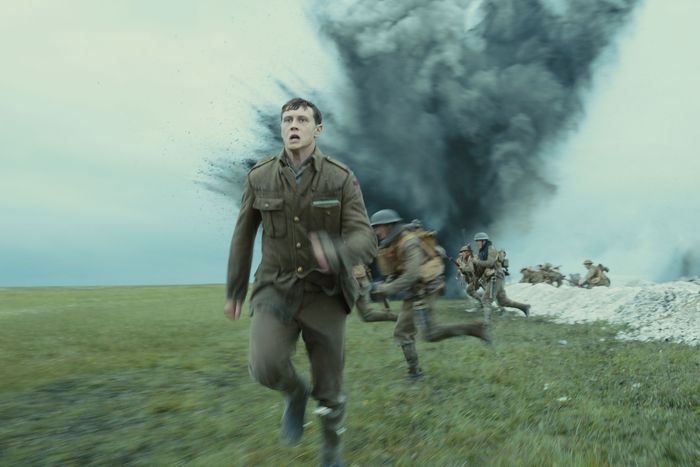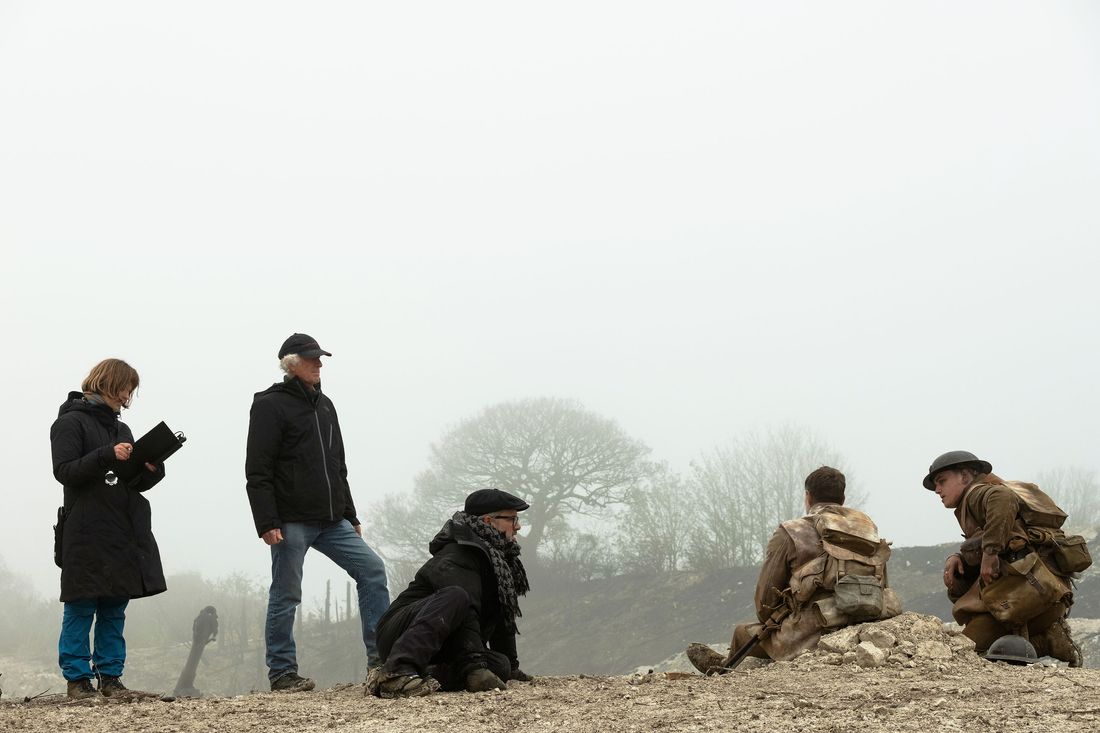
This article was featured in One Great Story, New York’s reading recommendation newsletter. Sign up here to get it nightly.
Midway through Sam Mendes’s 1917, a World War I soldier exits a truck, dives into a canal to avoid enemy fire, and emerges on the other side to confront a German sniper. Nailing such a thrilling set piece would be tough on any movie, but on 1917, the degree of difficulty was made even greater by the fact that, like the rest of the film, the sequence was meant to resemble a single continuous take. In reality, the scene spans 800 miles: The truck was based in Wiltshire in South West England, the canal in Scotland, the sniper in a studio backlot outside London. Every segment of the scene would have to be precisely choreographed to link up seamlessly with the last frame of the previous shot and the first frame of the subsequent one. Since there could be no visible cuts, any mistake would mean starting from the beginning.
1917 follows two soldiers, played by George MacKay and Dean-Charles Chapman, as they traverse the dreaded no man’s land to deliver a message whose contents are a matter of life and death to a British regiment preparing to clash with German forces. Mendes based the idea on his grandfather’s stories from the Western Front, and he came up with the single-take conceit as a way to ground the audience in every second of action. Most everyone agrees he pulled it off: 1917 won Best Director and Best Drama at the Golden Globes and earned ten Academy Award nominations, including Best Picture, Best Director, and Best Original Screenplay. It also seems to be a hit with audiences, pulling in $36 million over its first weekend of wide release.
Mendes’s astounding technical achievement could not have been accomplished without an army of trusted collaborators. Cinematographer Roger Deakins was responsible for the film’s balletic camera movements: In one sequence near the end of the film the camera begins on a crane, is carried through a battlefield by some grips, then gets put on the back of a vehicle, at which point the camera operators become extras. “It’s like gymnastics,” Deakins said. Production designer Dennis Gassner had to recreate the First World War landscapes, ones that stayed true to the period while veering away from the effluvia that marks other Great War tales. “Other people have made that movie, the blood and guts,” Gassner says. “This wasn’t that. This is a story about integrity, the willingness to do anything even in the harshest conditions.”
But as the crew members who shared memories of their most difficult days on set told us, 1917 was not all grueling stunts and camera work. Their hardships often came in the form of a hundred tiny dramas: a pair of birds that would not leave a nest, a cloud that was moving too slowly across the sky, the possibility of accidentally disinterring ancient Britons. Elsewhere the drama was as big as you’d expect: Even in the blockbuster era, very few film sets feature 500 extras dodging actual explosions. No matter the scale, though, each department had its part to play in creating the most visually immersive film of the season.
Location Scouting: The Day the Birds Moved In
Where to begin but at the beginning — the locations, which on 1917 were handled by location manager Emma Pill. Most World War I battlefields are sites of national remembrance, so Pill’s team needed to find homegrown matches for its Western Front. The film ostensibly takes place within an area that can be traversed by an adult man in two hours, but the real locations wound up being scattered across Britain: the wide-open fields of Salisbury Plain, a disused RAF base in Hertfordshire, a quarry in Oxfordshire, a canal in downtown Glasgow, and a white-water rafting center on the River Tees, plus — for a sequence set during a nighttime skirmish in the village of Écoust-Saint-Mein — a gigantic set at Shepperton Studios.
Of these, Salisbury Plain presented the most difficulties. The news that 1917 would be shooting two miles away from Stonehenge aroused a smattering of local controversy, and it was Pill’s job to ensure that production left only footprints — a considerable task, as they would be constructing full-scale World War I trenches on a property owned by Britain’s Ministry of Defense. “Normally with location movies, you’re in and out in a couple of weeks,” Pill says. Not here. Work on the trenches began months in advance of shooting; and once that was over, it took just as much time to fill them back in. From start to finish, Pill was working on the locations for up to eight months. “I learned so much about soil,” she said. “You have to put it back in a certain way. If you just throw it in, there’ll be a certain amount of sinkage over the winter.”
Even before digging into England’s pleasant pastures, one must take certain contingencies. Salisbury Plain is an area of remarkable archeological interest, so Pill had the fields geo-scanned to ensure production did not disturb any remnants of Bronze Age culture. That included any three-thousand-year-old corpses that may have been lying around. “I had to get a license to exhume bodies,” she recalled. “Obviously if they were modern bodies, you’re calling the police. But ancient bodies, you have to have a license to have permission to exhume them from the ground.” (They didn’t find any, but it’s always good to stay prepared.)
The living presented nearly as much concern. Salisbury Plain is renowned for being the home of two extremely rare kinds of wildlife: Chirocephalus diaphanus, a tiny shrimp that lives in puddles created by tank treads, and the stone curlew, one of Britain’s most elusive birds. Working with local environmental groups, Pill had to ensure the production did not interfere with the animals’ habitats. The Royal Protection Society for the Birds kept watch to make sure extras did not wander too close to stone curlew nests. Certain puddles were cordoned off, for the safety of the shrimp. “Every job’s different,” Pill said, laughing, “but this one was extraordinarily different.”
The birds’ comfort was ultimately not disturbed. In fact, sometimes they got too comfortable. Early in 1917, the two soldiers stumble upon an abandoned farm. This was not local; it was built by the movie’s production-design team, and needed to be torn down once filming was over. But when the time came to dismantle the structure, the crew made an unfortunate discovery. “We couldn’t strike the barn because some swallows and wagtails had decided it was a perfect environment to nest,” Pill recalled. It is against the law to disturb a birds’ nest, and so there was nothing to do but bring in an ornithologist, and watch and wait until each loving couple eventually flew the coop — which they finally did, weeks later. Pill can’t blame the birds: “It was the perfect barn in the middle of a perfect environment. They’re going to turn up next year and go, ‘Hang on a minute, where’s our barn?’”
Production Design: The Day a Freak Storm Wiped Out the Trenches
When Mendes sent out messages to his former co-workers asking them to be a part of 1917, it is likely none of them traveled further than the one sent to Dennis Gassner. The Oscar-winning production designer had taken a trip to Alaska with his wife in their vintage 1962 Airstream Bambi trailer. It was here that his email pinged for the first time in days: “Do not do the Bond film. I have a very ambitious film. Sending script.” In a sense, Gassner says, “that was the hardest day, making the decision” to turn down an offer to work on No Time to Die, the upcoming James Bond installment. But 1917 was to be his fifth movie with Mendes, his ninth with Roger Deakins. The allure of the old team getting back together again was too strong.
After signing on, Gassner was in for three months of “practical, daunting, and continuous” preproduction work: digging nearly a mile of trenches (each of which had to be calibrated to the distance the actors would travel while speaking the dialogue), building an entire farmhouse, erecting the bombed-out Écoust set. A former defensive lineman for the University of Oregon football team, Gassner prides himself on being up to such physical challenges. He estimates that on 1917, he walked an average of 12 miles a day. “I’ve been doing yoga for 40 years,” he says. “I swim, I hike, I do everything that I possibly can to keep myself ready for that phone call. You have to be game-ready.”
This hardiness came in handy during the film’s “tech recce,” a run-through where the unit heads visit the locations to walk through the film shot-by-shot, planning “the arduousness of every inch,” Gassner says. They arrived to scout the aforementioned French farmhouse — “a Dennis Gassner tour de force,” says producer Pippa Harris — which was in the process of being erected from scratch on Salisbury Plain. Suddenly, the weather rolled in.
“[The wind] felt like a million miles an hour, horizontal rain for three hours, pounding on us,” Gassner says. “Sam and I were sitting there nose-to-nose, trying to keep from blowing over. We had our hoods of rain gear over the top of it, looking through our little slits, and Sam goes, ‘You think this was what it was really like? This is fucking amazing. We actually get to live this experience like this.’”
That was Gassner’s experience in miniature. “Every day was hard,” he says, “because you never knew what you were going to get. But also it was an adventure, and there were no hard days.” It’s a very Zen mindset, which surely came in handy when that freak storm wiped out the trench sets Gassner and his team had painstakingly constructed. “You wake up and you go out and there’s two feet of snow on everything you’ve built. And you go, Well, shit, what are we going to do now? You start digging. You figure out a way to solve the problem, because that’s what the boys did back then.”
Producing: The Day We Couldn’t Shoot at All
Pippa Harris has been friends with Sam Mendes since childhood. Today, she’s his producing partner and one of his primary creative collaborators, who functions as a liaison with the studio on set, a boss who makes sure everything is running on time and the person a costume designer calls when they worry that actual-size WWI helmets would look too small on modern actors. (They decided to scale them up 8 percent.)
As it happens, Harris’s hardest day on set for 1917 was the very first day of filming. The movie takes place almost entirely outdoors, and those outdoor scenes are shot with natural light. To ensure proper continuity, filming could only take place on cloudy days. Few have ever gone broke betting on overcast skies in Britain, but as luck would have it, day one of the shooting schedule was a bright, sunny spring day. “Roger said to me, ‘I don’t think we’re going to be filming today.’ And I didn’t really want to hear that,” Harris said.
Mendes decided to use the downtime for more rehearsals with the actors; the trenches getting washed out had cut down on their ability to practice those sequences anyway. “What they were accomplishing was fantastic, but we weren’t turning over,” Harris recalled. “At about four or five in the afternoon, I got a slightly admonishing call from the studio, saying ‘You do realize you’re meant to email us when you first turn over?’ And I said, ‘Oh, well, we actually haven’t turned over yet.’ And that was of course not what the studio wants to hear on the first day of shooting.”
Fortunately, the extra rehearsal time paid off: By the end of the second day, they’d not just made up the lost time, but earned themselves a head start on day three. That pattern continued through the end of the shoot. “We’d get slightly behind, and then we’d get quite far ahead of ourselves, just in the rhythm of the way the work fell. That was hard to get used to. It was quite disconcerting, to be honest,” Harris says. “You couldn’t turn to the production-design team and say, ‘Actually, we’re going to be shooting on the Écoust set next week,’ because it simply wasn’t ready.”
The pace miraculously worked out, an accomplishment Harris credits to co-producer, first AD, and “brilliant scheduler” Michael Lerman. And in the end, she says, the movie did indeed come in “under time and under budget,” which might be the five sweetest words a producer could ever hear — after “and the winner is 1917,” of course.
Cinematography: The Day the Sun Came Out
Roger Deakins grew up in Torquay on the southwest coast of England, and in moments of homesickness, he misses the ever-changing British weather of his childhood. “I love a stormy day walking on the cliffs down in Devon,” he says. “There’s nothing better, really.” As a kid, he idly thought about studying meteorology at university. This youthful interest in weather systems would pay off on the set of 1917, where the best-laid plans of the filmmakers were frequently stymied by misbehaving clouds.
Having already lost the first official day of scheduled filming on account of too much sun, the weather became the cinematographer’s constant worry during production. “Every day was like scheduling for the clouds,” Deakins recalled. “I spent a lot of time watching the sky, and looking at weather apps on my phone, seeing when clouds might come in.” (He recommends Dark Sky, in case the app is looking for a celebrity endorser.) But even that was an imperfect method. “Sometimes you would think the radar would show a cloud system and some light rain coming towards you, but it would dissolve by the time it came to us. It was really frustrating.”
“On a film where you have cuts, we could make it work by doing a close-up and blocking the sun off the shot,” Deakins adds. But on a single-take set, “we couldn’t do that at all.”
As it had been on day one, the call for whether the light was right was up to Deakins. “A small cloud would come across the sky, and I was the one that had to say whether it was long enough or not,” he says. “If you’ve got a day when there’s only a few little fluffy clouds, you literally wait an hour or more for one of those clouds to build and get across the sun. You do a take, and if the take’s not good, you’re going to be waiting for the next little fluffy cloud another hour.” Like the ancient druids who had formerly roamed the same fields, Deakins found himself interpreting omens from the sky. “Sam always said to me, ‘It’s not your responsibility, don’t worry about it,’” he recalled. “I said, it’s easy to say that.’ It was much harder to feel relaxed about it.”
Even worse than not shooting, would have been jumping the gun and shooting too soon. Say Deakins made the decision to start filming, only for the sun to come out in the middle of one of the film’s incredibly long takes. The shot would have to be scrapped, and the whole machinery of production reset. “That would have been horrendous,” he said. “You didn’t want people to go through all that effort. But I didn’t want to shoot a shot I wasn’t happy with.”
Though his collaborators joke about him cursing the “evil sun,” the star also provided him with one of his favorite shots in the film. In the final moments of the movie, the sun peeks out from behind a cloud during a key emotional beat — nature doing Deakins’s work for him. It was a mixture of luck and skill. “I did calculate it on this cloud that was coming by,” he says. “I really wanted that feeling of the sun rising.”
Special Effects: The Day We Used Bespoke Flares
During these interviews, many of the subjects mentioned that “hardest” was not really the proper adjective to describe their days on the 1917 set. The cast and crew moved with such clarity of purpose, “what made the day most difficult was being the department that doesn’t mess up,” says Dominic Tuohy, the movie’s special-effects supervisor. “When you’ve got sequences that run for so long, and are so technical, you don’t want to be the department that has to go, ‘Okay, we didn’t get that. Back to one.’”
Being a war film, 1917 climaxes with an extended battle sequence that gave Tuohy and his team plenty to not mess up, as a battalion of troops advances in the face of German guns and artillery. Considering Tuohy’s three decades in the business have included gigs on Star Wars, Harry Potter, and the Marvel Cinematic Universe, there was a certain familiarity there. “The explosion [scenes], we’ve done that before,” he says. “That’s a special-effect man’s … not ‘bread and butter,’ because it’s a difficult thing to pull off, but explosions, people, safety — all that is something we do.”
A sequence shot at Shepperton Studios gave Tuohy the chance to stretch his brain. Deakins is legendary for his love of silhouettes, and he uses them in 1917, too: As MacKay traverses the ruined village, flares streak through the nighttime sky above him, bathing the set in an uncanny series of crawling shadows.
To create the effect Deakins was looking for, Tuohy and his team erected a network of winches held aloft on industrial cherry pickers 120 feet in the air. Putting film lights up there didn’t provide the right look, so they decided to go with magnesium flares, which had the right kind of flickering intensity. The flares would travel along the winches in a parabola — picture a ski lift, if a ski lift took you up in 15 seconds and down in three — and because of the one-shot nature of the film, the timing needed to be absolutely precise. The shadows would have to sync up with the movements of the actor and the camera crew, who had to get used to moments of complete darkness during their 300-foot run. (As did the sound and effects teams, who were jogging alongside them.) “You go from one second where it’s completely bright and you can see where you’re running,” says Tuohy. “Then it goes completely black and you’re running blind for a second or two. Then the next flare goes off and you get your bearing again.”
Oh, and to control the timing and color temperature, they also had to make the flares themselves. “They weren’t something you could buy off the shelves,” Touhy explained. “We made them bespoke.”
In all, Tuohy says, getting it right took doing the sequence “20 times, maybe more.” Though it was the most technically challenging assignment on the film, it was also his most unique accomplishment. “The saying in the film industry is, ‘Do something that’s never been done,’ and I can truly say that I don’t know of anybody that’s used flares in that [manner], to choreograph the shadows, use them as your friend and foe.”
Stunt Coordination: The Day 500 People Ran Into Battle
Before becoming a stunt coordinator, Ben Cooke worked as a stunt double for Daniel Craig, which is how he met Sam Mendes. It was fitting, then, that his work in the stunts department of 1917 would take place almost entirely without doubles, as the single-take conceit meant that they could never cut away. “Oftentimes, that’s a little insurance policy: If something’s a little tricky for an actor to do, I can throw a double in there. That was not an option on this particular film,” says Cooke.
With the exception of one single beat, Cooke says, “everything you see in the movie is George.” Dropping over a waterfall? That’s George MacKay. Getting completely buried under a pile of rubble? That’s George MacKay, too. “That could have been a nightmare for me if I got guys who weren’t up for it,” Cooke says. “But I was blessed with George and Dean. They did it.” Ten weeks of rehearsal helped, particularly in the canal scene, where MacKay had to emerge from the water, unhook his own safety cable without the movement being visible on camera, then continue on with the take — actual movie magic.
All of Cooke’s efforts paid off in the film’s bravura final sequence, which called for the actor to run through what feels like an entire regiment of extras storming out of a trench in doomed infantry charge. “Movies don’t necessarily get made like that anymore,” Cooke says. “They do crowd replication with VFX. We didn’t. Everybody there was real.” The scene features 450 extras, whose job was just to run, and 50 stuntmen, who essentially acted like human sheepdogs, shepherding the extras away from the high-explosive charges the effects team had planted in the ground. (According to Tuohy, there were 18 explosions in each run.) “We took it in baby steps,” Cooke says. “Doing it walking pace, speeding it up, slowly starting to introduce more people, setting up safe zones, having the hot seats that the stuntmen would be in and around the explosions.” Making it work took constant communication. “I broke the whole 500 into platoons, and then I’d put stuntmen like sergeants among the group,” he says. “I had everybody on the walkie-talkie.”
“We added to it layer by layer to get to the final result with everyone in there,” Cooke says of rehearsals. Once it came time to actually shoot the sequence, the energy was palpable. Since each explosion could only go off a certain number of times before having to be entirely reset, the number of takes was limited. (Touhy says they did it in three.) “It’s 500 people running into battle, so the crowds feed off each other. The image becomes very big,” Cooke said. Producer Harris felt the same way about the day they completed the decisive sequence. “When I look back on that day it makes me feel slightly frightened,” she says. “It’s like goosebumps of fear, because it was logistically just a huge challenge.”


